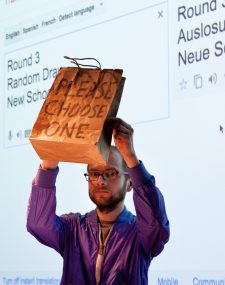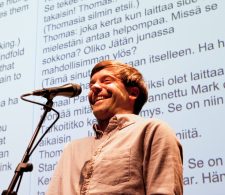Rita Raley teaches in the Department of English at the University of California, Santa Barbara. She has published on subjects ranging from Global English and universal alphabets to tactical media, dataveillance, machine translation, and electronic literature.

Authors | Rita Raley
Articles on Amodern by Rita Raley
AMODERN 8: TRANSLATION–MACHINATION
Amodern 8 explores the contexts and implications of translation as mechanism, media, technique, and transmission. Our tethering of “translation” to “machination” marks our intention to move beyond the habit of situating MT and computer-generated language in the familiar crisis poses of fakery, treason, and inauthenticity. Rather than regarding the machine as marking the limits of translation – an assumption that risks walling off translation practice from media and communication studies concerns, while still absorbing its products – our aim is to continue to investigate the possibilities and configurations of translation as machined, and translation as machining meaning, historically and in the contemporary moment.
Because “translation” can so easily be used metaphorically as a way to theorize all manner of signal recordings and transmissions, the term forsakes some of its practical solidity as attention shifts away from translation-as-it-happens to other media, other technologies, and other concerns. The metaphorical borrowings apply not only to translation, but to language as well. While it can certainly be generative to expand the translational scope to other media transformations, for the purposes of this special issue we have chosen to retain the more precise usage. In sum: we simply still care about language as a particular kind of medium – and in our contemporary computational environments, questions about what language is, how it moves, and how it is used, manipulated, maintained, transformed, and understood seem more pressing than ever before.
Our contributors grapple with such machinations by revisiting, uncovering, and extending machine translation’s historical record; by close reading translations, not primarily or only as hermeneutic inquiries, but as analyses of process and procedure; and, in a similar vein, by (re)activating machine translation development and operation through prototyping, re-creating, and experimenting with its devices and programs.
LOVE.ABZ AND THE TASK OF THE MACHINE TRANSLATOR
An Interview with Otso Huopaniemi
love.abz (2011-2015) was a series of performances that began when Finnish playwright and performance scholar Otso Huopaniemi ran his play, An ABZ of Love, through Google Translate, repeatedly translating from Finnish to English in a recursive loop. This poetic experiment in machine translation then evolved into a Babelian performance work that used live acting and live machine translation to explore the fragility of language and our ongoing relationship with machines, as well as questions of textual stability, semiosis, and authorship. love.abz was performed in New York, Berlin, Cardiff, Karlsruhe, and Helsinki, with several different casts and using a variety of languages. In this extended dialogue, Huopaniemi and Rita Raley together consider "the task of the machine translator."





